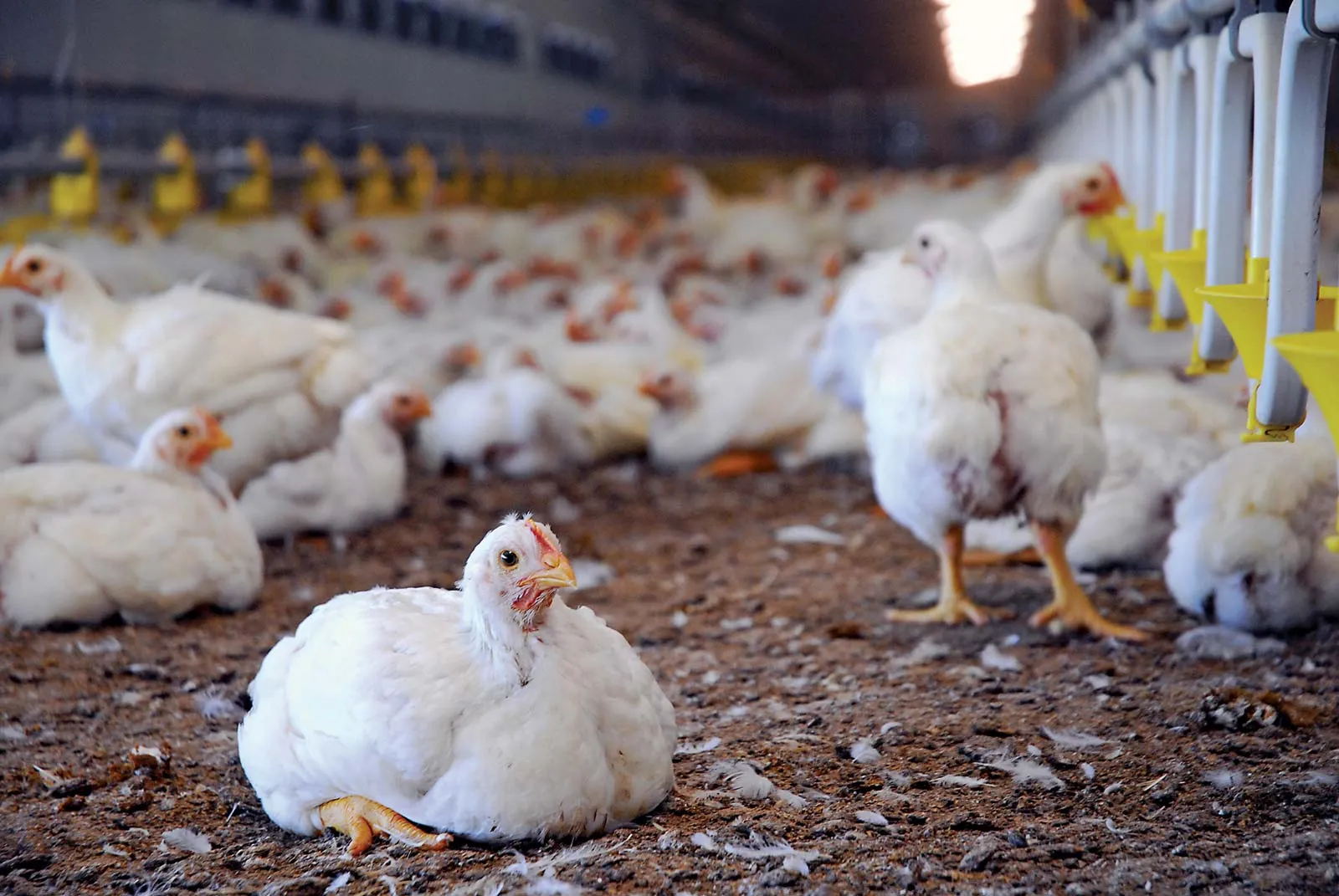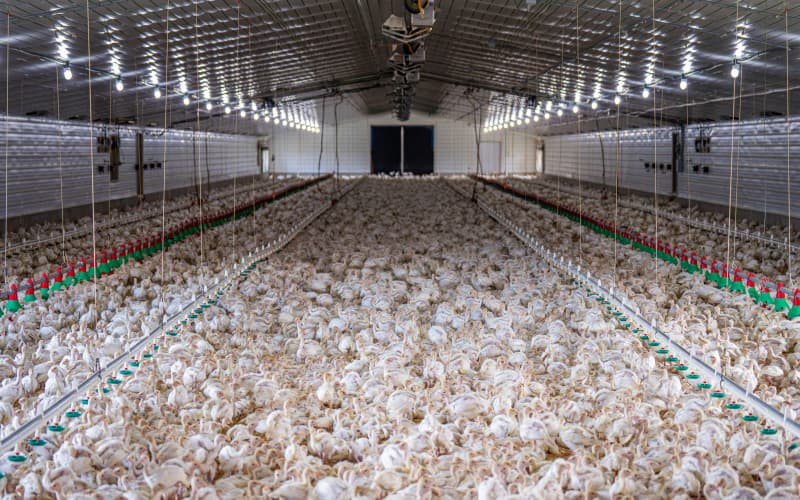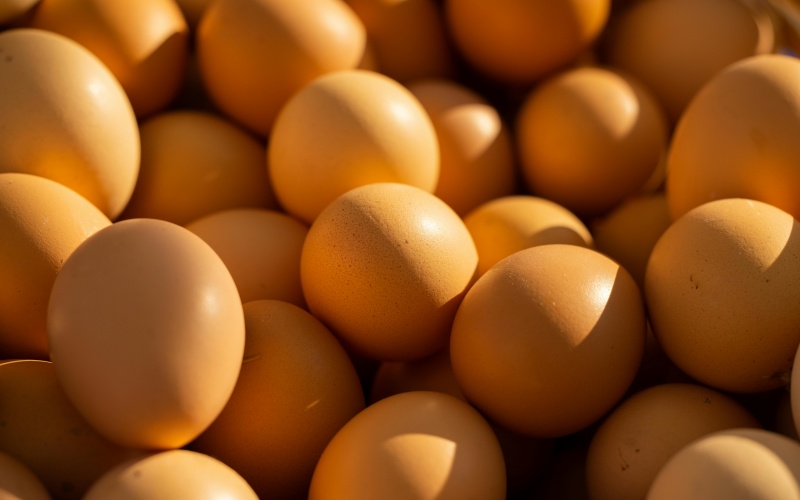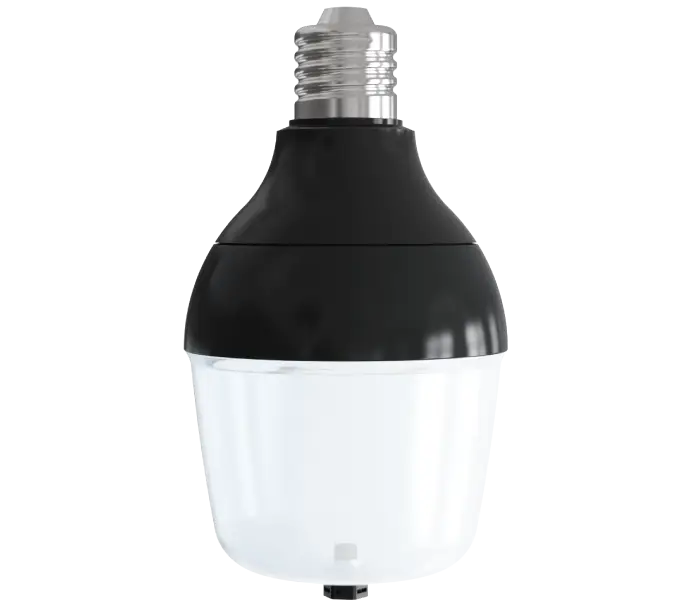家禽照明如何影响生产和生长?

目录:
1. 为什么家禽照明灯对现代农场至关重要?
人们通常误以为养鸡场安装照明是为了方便工作人员操作。但实际上,养鸡场的照明会直接影响家禽的生理机能。
鸡和其他家禽感知的光谱范围比人类更广,包括紫外线,它们的生长和繁殖与光信号密切相关。光照的持续时间、强度和光谱通过下丘脑-垂体-性腺轴影响激素释放,从而调节产蛋、生长和生育能力。
在封闭式或大型养鸡场中,自然光照要么不稳定,要么完全缺失。缺乏适当的人工照明会导致蛋鸡产蛋率下降、肉鸡生长不均,种鸡繁殖力降低。因此,有效的照明并非可有可无,而是确保更高产、鸡群行为稳定和饲料转化率的关键管理手段。

2. 家禽照明关键参数详解
鸡舍的LED照明 不仅仅是开关灯那么简单。光周期、强度、光谱和节奏这四个技术因素共同作用,影响着家禽的生长、行为和产蛋量。
下面我们将用简单的术语来分解它们,重点介绍蛋鸡、肉鸡和种鸡的不同需求。
2.1 光照周期——“灯应该开多久?”
每日光照时长直接影响鸟类的生长和繁殖周期。养殖户必须根据鸟类的种类和生长阶段来调整光照时间:
(1)蛋鸡:
产蛋期:需要14-16小时的持续光照(例如,16小时光照:8小时黑暗)。如果光照时间低于12小时(例如在冬季),母鸡会收到“停止产蛋”的信号。
雏鸡饲养(0-6周):光照时间逐渐从24小时减少到8-10小时。这可以防止母鸡过早成熟。
(2)肉鸡:
它们一生需要18-22小时的光照。日照时间长会延长进食时间,从而促进体重增加。然而,至少2-4小时的黑暗对于休息和缓解压力至关重要。
(3)育种者:
光照时间应模拟自然季节变化。逐渐延长日照时间可提高受孕率和产卵率。
常见错误:认为“时间越长越好”。例如,给蛋鸡20小时以上的光照实际上会给母鸡带来压力,降低受孕率,并减少产蛋量。
2.2 光照强度——“应该有多亮?”
光照强度以勒克斯(Lux)为单位(1勒克斯≈阴天室内房间的亮度)。不同生长阶段和家禽品种对光照强度的要求也不同:
(1)育雏(0-2 周):20-30 勒克斯。明亮的光线有助于雏鸡快速找到饲料和水,降低早期死亡率。
(2)产蛋鸡(生产阶段):光照强度10–20勒克斯。光照过强(>30勒克斯)会导致母鸡烦躁不安,并出现啄羽等有害行为。光照过弱(<5勒克斯)会降低采食量和产蛋量。
(3)肉鸡(育肥期):5-10勒克斯。较低的光照强度可使鸡只保持平静,减少运动造成的能量浪费,并促进快速增重。
实用技巧:灯光必须均匀分布在房屋内。避免出现暗角(<3勒克斯)或强光点。调整吊灯高度(离地2-3米)和灯具间距(每隔2-3米),以达到平衡。
2.3 光谱成分——“哪些颜色最重要?”
近年来,家禽照明研究的重点是光谱优化,挑战了“任何白光都可以”的旧观念。
传统白炽灯偏向暖光(以红色为主),而荧光灯偏向冷光(以蓝色为主)。然而,两者的光谱范围都有限,无法精确满足家禽的需求。
相比之下,LED光谱可以定制,每个波长都发挥着不同的作用:
红光 (620–660纳米)可促进蛋鸡产蛋,并加速肉鸡增重;
蓝光 (450-495纳米)抑制肉鸡活动,但可能引起应激;
绿光 (520–560纳米)有助于增加鸡蛋重量;
UV -A(320–400 nm)支持维生素D3的合成,但需要严格控制。
实际上,建议蛋鸡舍采用以红色波长为主的混合光,而肉鸡舍则应优先采用蓝色含量较低的暖红色光。
2.4 光照节律——“连续还是间歇?”
照明计划可以是连续的,也可以是循环的:
(1)持续照明:
例子:
连续16小时。方法简单,但能耗高,而且会让鸟儿更容易疲劳。
(2)间歇照明:
例子:
分层:2 小时光照 / 2 小时黑暗(重复)。
肉鸡:1 小时光照/3 小时黑暗(循环)。
间歇性节律的益处:
节能30-50%。
让鸟类获得更多休息,降低压力和攻击性。
研究表明,与持续光照相比,产蛋率可以略有提高。
重要提示:作息规律必须保持稳定。频繁的改变会扰乱昼夜节律,给鸡群带来压力。
简而言之:
When applied correctly, these parameters transform lighting from a utility into a powerful tool for poultry performance.
3. From “Traditional Lamps” to “Smart Lighting”
Lighting technology in poultry farming has changed dramatically over the past few decades. Each stage brought progress, but also limitations that explain why farms are now moving toward LED and smart systems.
Incandescent lamps were once the standard. Their spectrum is close to natural sunlight and the upfront cost is low. However, they waste most energy as heat, last only about 1,000 hours, and are unsuitable for modern large-scale houses. They remain practical only for small backyard or temporary setups.
Fluorescent lamps reduced energy use compared to incandescent and provided stronger brightness. Yet, they rely on fixed spectral output, contain mercury, and typically last around 8,000 hours. Many mid-sized farms adopted them during the transition era, but environmental concerns and limited spectral control restrict their value today.
LED lights have become the mainstream choice. They cut energy consumption by up to 70%, operate over 50,000 hours, and allow tailored spectral design for broilers, layers, or breeders. They are also mercury-free and environmentally friendly. While the initial cost is higher, the long-term performance and efficiency make LEDs the most cost-effective option for intensive poultry houses.
The latest step is smart LED systems. Beyond efficiency, they enable remote control via apps or central management software, automatic scheduling of photoperiods, and integration with climate sensors for temperature and humidity. These systems adjust lighting programs dynamically, ensuring optimal growth and reproduction with minimal manual intervention. Their upfront cost and need for professional setup are higher, but for modern farms aiming at precision management, smart lighting delivers unmatched benefits.

4. Tailored Lighting Plans for Different Poultry Types
Lighting strategies should never be “one size fits all.” Different poultry categories respond uniquely to light, so farmers must adapt programs for layers, broilers, and breeders.

(1) Laying hens (layers)
Photoperiod: 16 hours of light during production (e.g., 5:00–21:00) and 8 hours in the resting phase.
Intensity: 15 Lux evenly across the house; avoid shadowed corners below 10 Lux.
Spectrum: Red-to-blue ratio of 3:1 (around 660 nm red + 450 nm blue), with limited UV-A exposure (1–2 hours daily) to improve calcium absorption and shell strength.
Rhythm: Intermittent cycles (2 h light + 2 h dark) help conserve energy while reducing stress behaviors.
Know more details about Chicken Coop Lighting for Egg Production.
(2) Broilers (meat birds)
Photoperiod: 24 h light in the brooding phase (0–2 weeks), then 20 h light + 4 h dark from week 3 onward (e.g., 6:00–2:00).
Intensity: 25 Lux during brooding to encourage feeding and drinking; reduce to 8 Lux in the grow-out phase to limit activity and improve feed conversion.
Spectrum: Dominantly red (≈70% at 660 nm) with minimal blue (<10%) to minimize stress.
Rhythm: Continuous light early, then switch to intermittent cycles (1 h light + 3 h dark) to balance growth and rest.
(3) Breeders
Photoperiod: Seasonal simulation—gradually extend daylight hours from 12 to 16 as in spring.
Intensity: 15–20 Lux, strong enough to support activity but not excessive, which could disrupt mating.
Spectrum: Broad-spectrum lighting (red, green, blue) to mimic natural daylight and stimulate breeding behaviors.
Rhythm: Continuous light during the active phase to maintain consistent mating patterns.
When applied correctly, these tailored lighting programs improve performance, welfare, and efficiency across all poultry houses.
5. Common Problems in Poultry Lights and Solutions
Even with well-planned programs, lighting issues often appear in daily farm management. Below are the most frequent problems and actionable poultry lighting solutions.
Problem 1: Uneven light distribution
Cause: Lamps hung too high, wide spacing between fixtures, or insufficient lamp power.
Solution: Use a staggered hanging pattern instead of straight lines. Choose wide-angle LED lamps (≥120° beam angle). Add supplemental lights in corners to eliminate dark spots.
Problem 2: Sudden drop in egg production (excluding disease)
Possible causes: Shortened photoperiod due to timer failure, reduced light intensity from faulty lamps, or abrupt spectral changes after replacing bulbs.
Solution: Check timers and fixtures weekly. When replacing lights, phase in the new lamps over 1 week before a full switch. Keep photoperiod, intensity, and spectrum stable unless deliberately adjusted for growth stage.

Problem 3: Feather pecking or cannibalism in broilers
Causes: Excessive brightness (>10 Lux), too much blue light, or insufficient dark periods.
Solution: Reduce light intensity to 5–8 Lux. Shift spectrum toward red while reducing blue. Guarantee at least 4 continuous dark hours daily for rest.
Problem 4: High lighting costs
Solution: Upgrade to LED lamps to save up to 70% energy. Apply intermittent lighting cycles to reduce operating hours. Install smart controllers that adjust brightness automatically with daylight, lowering artificial light use during sunny hours.
6. Smart & Green Future of Poultry LED Lighting
The future of poultry lighting is moving beyond simple illumination. For large-scale farms, the next decade will be defined by smart integration and sustainable design.
6.1 Smart upgrades
Light–climate–feed integration: Smart systems will connect lighting with temperature, humidity, and feed intake data. For example, during heat stress, the system can automatically dim lights to reduce metabolic load.
Targeted lighting: With cameras and sensors, farms may provide individualized light programs. Weak or sick birds could receive longer photoperiods to encourage feeding, while the rest of the flock follows standard cycles.
Data-driven management: Systems will log photoperiods, intensity, and production metrics like egg count or weight gain. AI analysis will then suggest or automatically apply optimized lighting schedules tailored to each flock’s performance.
6.2 Green development
Energy efficiency: Research is pushing LED efficiency beyond 150 lumens per watt, cutting power costs further. Solar-assisted systems are likely to become viable for remote or off-grid farms.
Eco-friendly materials: Mercury-free, recyclable fixtures will become the industry standard, aligning with environmental regulations and farm sustainability goals.
Welfare-focused lighting: Welfare directives, especially in Europe, are driving adoption of sunrise–sunset simulation instead of abrupt on/off cycles. Such gradual transitions reduce stress and improve overall flock health.
As technology advances, poultry LED lighting will no longer be just about visibility—it will become a central tool for precision farming, sustainability, and animal welfare.
7. Conclusion: Poultry Lights as a High-Return Investment
For farmers, poultry lighting is not a background detail—it is a direct driver of production, welfare, and profitability. The right program can improve egg yield, shorten growth cycles, and reduce stress, while poor lighting undermines all of these.
Traditional lamps may seem affordable, but their high energy use, short lifespan, and limited control make them costly over time. By contrast, poultry LED lighting offers precise spectrum tuning, stable intensity, and smart automation that align with modern farm needs. It reduces electricity bills, lowers maintenance, and creates healthier conditions for layers, broilers, and breeders alike.
The path forward is clear: adopting poultry LED lighting is not just an upgrade—it is an investment in long-term performance, sustainability, and competitiveness. For farms aiming to maximize efficiency and prepare for future demands, switching to LED is the most practical and profitable decision today.
Related Product


8. FAQs
Q1: Which light is better for broilers?
答:白光(全光谱LED灯)最适合肉鸡。与红光相比,白光可使采食量、肌肉生长和体重增加提高8-10%。白光还有助于保持稳定的饲料转化率(白光下饲料转化率为1.6,而红光下为1.8)。
Q2:为什么红光照射会导致产卵量减少?
答:红光可能过早触发催产素释放,缩短卵黄沉积时间。这会导致30周后鸡蛋重量降低。可通过在筑巢区域添加绿光(5勒克斯)来改善钙代谢和蛋壳质量,从而弥补这一不足。
Q3:红光能提高蛋鸡的产蛋量吗?
答:是的,红光(660纳米)通过刺激生殖激素,在长期使用(18-60周)过程中加速性成熟并增加产卵量。然而,与白光或绿光相比,红光照射下产出的卵重量始终较小,尤其是在30周后。
就鸡蛋质量而言,绿光优于红光,能产生更厚更坚固的蛋壳。
Q4:红光如何影响鸡的行为?
答:红光波长较长(660纳米),对昼夜节律的干扰最小,因此能减轻压力。它能促进动物的被动行为(休息、梳理羽毛),并减少群体中的攻击性。
相比之下,蓝光会增加家禽的焦虑(例如,喘气、鸭群聚集),而白光则能维持行为稳定性。
_thumb.jpg)
